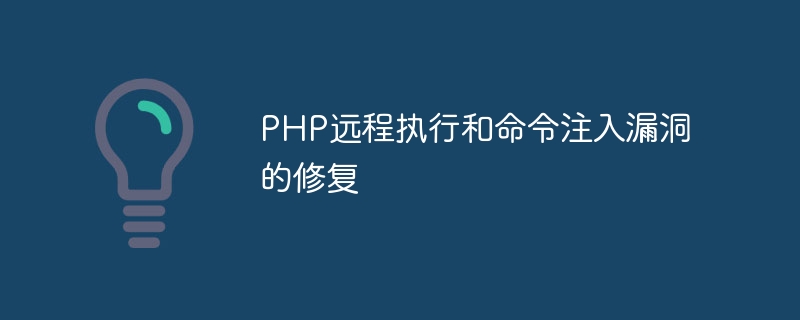Home >Backend Development >PHP Tutorial >Fixes for PHP remote execution and command injection vulnerabilities
Fixes for PHP remote execution and command injection vulnerabilities
- 王林Original
- 2023-08-14 20:10:421669browse

Title: Fix for PHP Remote Execution and Command Injection Vulnerabilities
Introduction:
In web development, PHP is a widely used back-end programming language . However, due to the characteristics of PHP and incorrect code writing, it is easy to cause some security vulnerabilities, such as remote execution vulnerabilities and command injection vulnerabilities. This article explains how these two vulnerabilities work and provides code examples to fix them.
1. Principle of remote execution vulnerability
Remote execution vulnerability means that the attacker causes the server to perform unexpected operations by sending malicious code. Remote execution vulnerabilities may occur when developers use unsafe functions (such as eval()) or do not properly sanitize user input.
The following is a sample code that demonstrates how to execute malicious code through a remote execution vulnerability:
$code = $_GET['code']; eval($code);
The method to fix the remote execution vulnerability is to execute without using the eval() function Code entered by the user. An alternative could be to use a safer function such as exec(), system(), or passthru(). The commands executed by these functions are fixed and cannot be changed based on user input.
The following is a code example to repair the remote execution vulnerability:
$code = $_GET['code'];
$result = exec("command ".$code); // command为需要执行的命令2. The principle of command injection vulnerability
The command injection vulnerability means that the attacker injects commands into the data entered by the user. thereby performing unexpected operations. Command injection vulnerabilities may occur when developers use user input to directly splice commands or do not perform reasonable filtering and verification of user input.
The following is a sample code that demonstrates how to perform unexpected operations through a command injection vulnerability:
$cmd = $_GET['cmd'];
system("ping -c 4 ".$cmd);The method to fix the command injection vulnerability is to fully filter and validate user input to ensure that the input The command does not contain any malicious code. The simplest method is to use the escapeshellcmd() function to escape the command.
The following is a code example to fix the command injection vulnerability:
$cmd = $_GET['cmd'];
$cmd = escapeshellcmd($cmd);
system("ping -c 4 ".$cmd);Conclusion:
Remote execution vulnerabilities and command injection vulnerabilities are caused by developers not fully considering the security of user input. security vulnerabilities. In order to fix these vulnerabilities, developers need to use safe functions and reasonable filtering/validation mechanisms to prevent the execution of malicious code. During the actual development process, developers should always pay attention to security issues and code according to best practices to ensure the security of the application.
The above is the detailed content of Fixes for PHP remote execution and command injection vulnerabilities. For more information, please follow other related articles on the PHP Chinese website!

